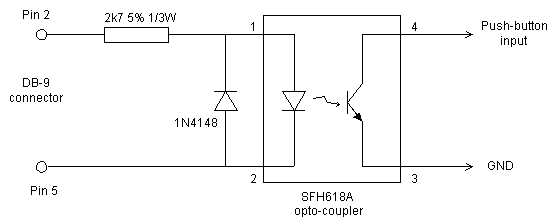
Mains Remote Alarm

Beeper and/or LED remotely-operated via mains supply line. Pressing the pushbutton of the transmitter, a sound and/or light alert is activated in the receiver. The system uses no wiring or radio frequencies: the transmitted signal is conveyed into the mains supply line. It can be used at home, in any room from attic to cellar, simply plugging transmitter and receiver in the wall mains sockets. Transmission range can be very good, provided both units are connected to the mains supply within the control of the same light-meter. Simple circuitry, easy to build units. More: Q1 and Q2 are wired as a Darlington pair to obtain the highest possible output from a Hartley type oscillator running at about 135KHz frequency. The 230Vac mains is reduced to 30Vdc without the use of a transformer by means of C2 reactance, a two diode rectifier.
This circuit operates as a remote alerting system utilizing the existing mains supply for communication between a transmitter and a receiver. The transmitter unit is equipped with a pushbutton that, when pressed, activates a sound (beeper) and/or light (LED) alert in the receiver unit. The unique aspect of this design is its ability to transmit signals through the mains wiring, eliminating the need for additional wiring or radio frequency components.
In the transmitter circuit, the main components include a Darlington pair configuration formed by transistors Q1 and Q2. This configuration is chosen to amplify the output signal from the oscillator, which is designed as a Hartley oscillator operating at approximately 135 kHz. The oscillator generates a high-frequency signal that is modulated by the pushbutton activation. The output from the oscillator is then coupled into the mains supply line.
To power the transmitter, the circuit converts the 230Vac mains voltage down to a lower DC voltage suitable for the circuit's operation. This is achieved through a capacitive dropper method using capacitor C2, which provides reactance to limit the current flowing into the circuit. A two-diode rectifier configuration follows, converting the AC signal into a pulsating DC signal, which is then smoothed to provide a stable supply voltage (approximately 30Vdc) for the circuit.
The receiver unit is designed to detect the modulated signals transmitted through the mains. It consists of a similar rectifying circuit to extract the transmitted signal, which is then processed to activate either the beeper or the LED. The design ensures that the system can operate over a considerable distance, as long as both the transmitter and receiver are plugged into the same electrical circuit.
Overall, this remote alert system is characterized by its simplicity, ease of assembly, and effective use of existing electrical infrastructure, making it suitable for various applications in residential settings.Beeper and/or LED remotely-operated via mains supply line. Pressing the pushbutton of the transmitter, a sound and/or light alert is activated in the receiver. The system uses no wiring or radio frequencies: the transmitted signal is conveyed into the mains supply line. It can be used at home, in any room from attic to cellar, simply plugging transmitter and receiver in the wall mains sockets.
Transmission range can be very good, provided both units are connected to the mains supply within the control of the same light-meter. Simple circuitry, easy to build units. Q1 and Q2 are wired as a Darlington pair to obtain the highest possible output from a Hartley type oscillator running at about 135KHz frequency. The 230Vac mains is reduced to 30Vdc without the use of a transformer by means of C2 reactance, a two diode re
🔗 External reference
This circuit operates as a remote alerting system utilizing the existing mains supply for communication between a transmitter and a receiver. The transmitter unit is equipped with a pushbutton that, when pressed, activates a sound (beeper) and/or light (LED) alert in the receiver unit. The unique aspect of this design is its ability to transmit signals through the mains wiring, eliminating the need for additional wiring or radio frequency components.
In the transmitter circuit, the main components include a Darlington pair configuration formed by transistors Q1 and Q2. This configuration is chosen to amplify the output signal from the oscillator, which is designed as a Hartley oscillator operating at approximately 135 kHz. The oscillator generates a high-frequency signal that is modulated by the pushbutton activation. The output from the oscillator is then coupled into the mains supply line.
To power the transmitter, the circuit converts the 230Vac mains voltage down to a lower DC voltage suitable for the circuit's operation. This is achieved through a capacitive dropper method using capacitor C2, which provides reactance to limit the current flowing into the circuit. A two-diode rectifier configuration follows, converting the AC signal into a pulsating DC signal, which is then smoothed to provide a stable supply voltage (approximately 30Vdc) for the circuit.
The receiver unit is designed to detect the modulated signals transmitted through the mains. It consists of a similar rectifying circuit to extract the transmitted signal, which is then processed to activate either the beeper or the LED. The design ensures that the system can operate over a considerable distance, as long as both the transmitter and receiver are plugged into the same electrical circuit.
Overall, this remote alert system is characterized by its simplicity, ease of assembly, and effective use of existing electrical infrastructure, making it suitable for various applications in residential settings.Beeper and/or LED remotely-operated via mains supply line. Pressing the pushbutton of the transmitter, a sound and/or light alert is activated in the receiver. The system uses no wiring or radio frequencies: the transmitted signal is conveyed into the mains supply line. It can be used at home, in any room from attic to cellar, simply plugging transmitter and receiver in the wall mains sockets.
Transmission range can be very good, provided both units are connected to the mains supply within the control of the same light-meter. Simple circuitry, easy to build units. Q1 and Q2 are wired as a Darlington pair to obtain the highest possible output from a Hartley type oscillator running at about 135KHz frequency. The 230Vac mains is reduced to 30Vdc without the use of a transformer by means of C2 reactance, a two diode re
🔗 External reference





